Number Systems | Computer Science - Answer the following questions | 11th Computer Science : Chapter 2 : Number Systems
Chapter: 11th Computer Science : Chapter 2 : Number Systems
Answer the following questions
Fundamentals of Computers
Number Systems
Evaluation
II. Very Short Answers
1. What is data?
Answer: The term data comes from the word datum, which means a raw fact.
The data is a fact about people, places or some objects.
2. Write the 1’s complement procedure.
Answer:
Step 1: Convert given Decimal number into Binary
Step 2: Check if the binary number contains 8 bits, if less add 0 at
the left most bit, to make it as 8 bits.
Step 3: Invert all bits (i.e. Change 1 as 0 and 0 as 1).
3. Convert (46)10 into Binary number
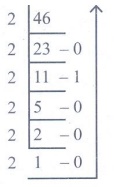
4610 = (101110)2
4. We cannot find 1’s complement for (28)10. State reason.
Answer: (28)10 is positive number. 1’s Complement represent
signed numbers (Negative numbers) only. So, (28)10 cannot find 1’s
complement.
5. List the encoding systems for characters in memory.
Answer: (i) BCD - Binary Coded Decimal.
(ii) EBCDIC - Extended Binary Coded Decimal Interchange Code.
(iii) ASCII - American Standard Code for Information
Interchange.
(iv) Unicode.
(v) ISCII - Indian Standard Code for Information Interchange.
III. Short Answers
1. What is radix of a number system? Give example
Answer: A numbering system is a way of representing numbers. Each number
system is uniquely identified by its base value or radix. Radix or base is the
count of number of digits in each number system. Radix or base is the general
idea behind positional numbering system.
Example :
Binary Number System - Radix 2
Octal Number System -
Radix 8
Decimal Number System -
Radix 10
Hexadecimal Number System
- Radix 16.
2. Write note on binary number system.
Answer: (i) There are only two digits in the Binary system, namely, 0
and 1. The numbers in the binary system are represented to the base 2 and the
positional multipliers are the powers of 2.
(ii) The left most bit in the binary number is called as the
Most Significant Bit (MSB) and it has the largest positional weight.
(iii) The right most bit is the Least Significant Bit (LSB) and
has the smallest positional weight.
3. Convert (150)10 into Binary, then convert that Binary number to Octal
Answer:
15010 = ?
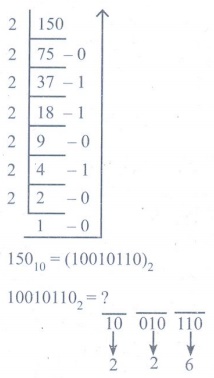
100101102 = 2268.
4. Write short note on ISCII
Answer: (i) ISCII is the system of handling the character of Indian
local languages. This as a 8-bit coding system.
(ii) Therefore it can handle 256 (28) characters. This system is
formulated by the department of Electronics in India in the year 1986-88 and
recognized by Bureau of Indian Standards (BIS).
(iii) Now this coding system is integrated with Unicode.
5. Add a) -2210+1510 b) 2010+2510
Answer:
(a) −2210 + 1510
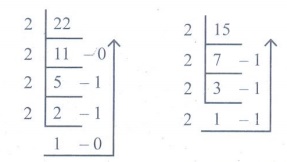
(1111)2 ⇒ (00001111)2
(10110)2 ⇒ (00010110)2
1’s complement = 11101001
2's complement = 11101010
(−22)10 + (15)10 = 11101001
= 00001111
==========
11111001
==========
(b) 2010 + 2510

2010 + 2510 = 001011012
IV. Detail Answers
1. a) Write the procedure to convert fractional Decimal to Binary
b) Convert (98.46)10 to Binary
Answer:
a) The method of repeated multiplication by 2 has to be used to
convert such kind of decimal fractions. The steps involved in the method of
repeated multiplication by 2:
Step 1: Multiply the decimal fraction by 2 and note the integer part.
The integer part is either 0 or 1.
Step 2: Discard the integer part of the previous product. Multiply the
fractional part of the previous product by 2. Repeat Step 1 until the same
fraction repeats or terminates (0).
Step 3: The resulting integer part forms a sequence of 0s and 1s that
become the binary equivalent of decimal fraction.
Step 4: The final answer is to be written from first integer part
obtained till the last integer part obtained.
(b) 98.4610
1. Integer part
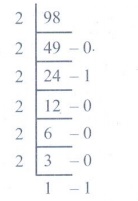
2. Fractional part
0.46 × 2 = 0.92 = 0
0.92 × 2 = 1.84 = 1
0.84 × 2 = 1.68 = 1
0.68 × 2 = 1.36 = 1
0.36 × 2 = 0.72 = 0
0.72 × 2 = 1.44 = 1
98.4610 = (1100010.011101....)2
2. Find 1’s Complement and 2’s Complement for the following Decimal number
a) -98 b) -135
Answer:
a) -98
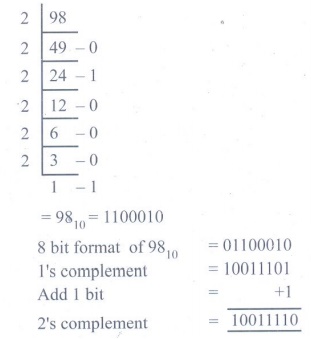
b) -135
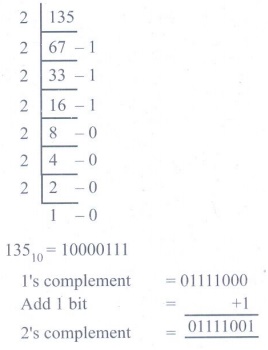
3. a) Add 11010102+1011012
b) Subtract 11010112 - 1110102
Answer:
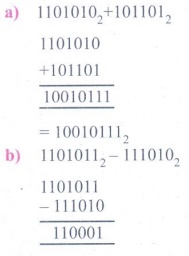
Related Topics